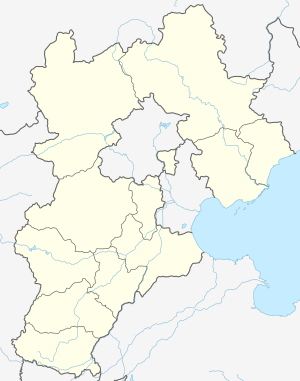Anji Bridge
Coordinates: 37 ° 43 ′ 13 ″ N , 114 ° 45 ′ 48 ″ E
| Anji Qiao | ||
|---|---|---|
| Convicted | formerly Zhaoxin Street, now a park | |
| Subjugated | Xiehong Canal | |
| place | Zhao Xian, Shijiazhuang , Hebei , People's Republic of China | |
| construction | Segment arch bridge | |
| overall length | 50 m | |
| width | 9 m | |
| Longest span | 37 m | |
| start of building | 595 | |
| completion | 605 | |
| planner | Li Chun | |
| location | ||
|
|
||
The Anji Bridge ( Chinese 安 濟 橋 / 安 济 桥 , Pinyin Ānjì Qiáo - "Bridge of Safe Crossing"), also known as the Zhaozhou Bridge ( Chinese 趙州 橋 / 赵州 桥 , Pinyin Zhàozhōu Qiáo ) or sometimes simply called Dashi Bridge ( Chinese 大 石橋 / 大 石桥 , Pinyin Dàshí Qiáo - "big stone bridge / bridge of big stones"), is the oldest segment arch bridge in China . It spans the Xiao River in Hebei Province , about 40 km southeast of the provincial capital Shijiazhuang .
Building description
The bridge has a total length of 50 m with an arch width of 37 m. It is 7.3 m high and 9 m wide. Each arc describes a little less than a semicircle. The ratio between span and crown height is about 1: 5, so it is significantly smaller than the ratio for an arch bridge made of semicircular segments. As a result, the bridge piers are exposed to relatively high forces.
The central arch consists of 28 thin, arched limestone slabs connected with iron prongs. This allows the arch to transfer shear forces into the supports . The bridge has two side arches on both sides. These fulfill two important functions: First, they reduce the total weight of the bridge considerably by around 700 t. In addition, in the event of a flood , they enable the arch openings to flow away without damaging the bridge.
Building history
The Anji Bridge was built between 595 and 605 during the Sui Dynasty . It is awarded to the builder Li Chun (李春). Since it was built, it has withstood ten severe floods , eight battles and numerous earthquakes , including one with a magnitude of 7.2 in 1966. The bridge is still in use, only the ornate railings have been replaced several times.
reception
The shape of the bridge, which was unusual for the construction period, gave rise to legends. A legend , according to the bridge by the renowned architect of Chinese history named Lu Ban (魯班/鲁班) was built in a single night. Another legend tells that the bridge was crossed by two immortals at the same time as a test and that Lu Ban stepped into the water and the bridge withstood with his support.
The bridge was mentioned in the literature of the Ming Dynasty but was later forgotten. It was only rediscovered during field research in the 1950s by Professor Liang Sicheng of Tsing Hua University. He measured the bridge and published an article about it. Only then did the bridge become world famous.
The bridge has been on the list of monuments of the People's Republic of China since 1961 . In 1989 the American Society of Civil Engineers added it to the list of historical milestones in engineering .
Individual evidence
- ↑ It is not the oldest bridge of this type. Segment arch bridges can be found earlier with the Romans , such as B. the approx. 300 years older bridge at Limyra , the bridge of Alconétar (2nd century AD) or the Ponte San Lorenzo in Padua (1st century BC)
literature
- Bernhard Graf: Bridges that connect the world. Munich 2002, pp. 24-25.
- Charlotte Jurecka: Bridges. 2nd edition, Vienna 1986, p. 36.
- Marcel Prade: Les grands ponts du monde: Hors d'Europe. Poitiers 1990, p. 219.

